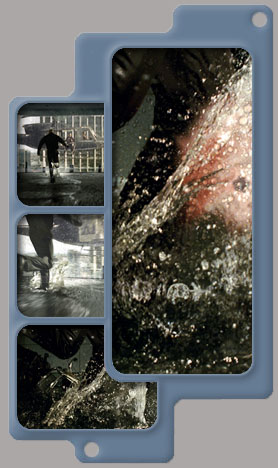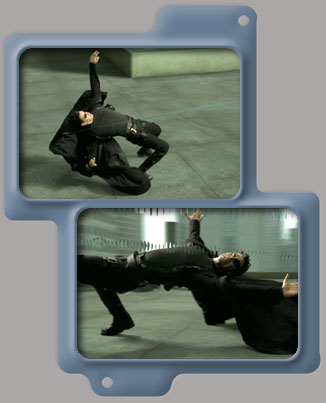Without SOFTIMAGE|3D and mental ray, specifically, those phenomenal bullet time backgrounds just wouldn't have been possible.
Without SOFTIMAGE|3D and mental ray, specifically, those phenomenal bullet time backgrounds just wouldn't have been possible.
George Borshukov, Manex R&D
Virtual Cinematography Technical Designer
Hot on the heels of the Oscar winning "What Dreams May Come" the team
at Manex Entertainment has opened the door into yet another reality, a virtual one, known
as "The
Matrix". The entire film takes place inside the virtual world of The Matrix, a
place where nothing is real and anything is possible. Manex's George Borshukov,
R&D/Virtual Cinematography Technical Designer, and the in-house R&D team have
written close to 30 Sapphire plug-ins for SOFTIMAGE|3D to facilitate the revolutionary
image-based rendering technique for backgrounds. This technique was used on certain scenes
in "Dreams", which won the award for Best Achievement in Visual Effects, and
brought the high-tech action scenes in "The Matrix" to life. The results this
time around are some stunning ultra slow motion fight scenes, where the camera perspective
constantly changes, and CG backgrounds surpass the quality of anything done previously.
"The Matrix" project took roughly two years to complete, with a full year of pre-production and then another year to produce the 100 extremely complex shots that have made the film a box-office hit. A good chunk of this time was spent creating shots using a new technique, coined "bullet time". Each shot took about nine months to create—from pre-visualisation in SOFTIMAGE|3D to completion.
|
The technique was based on work that Borshukov developed with researcher Paul Debevec at UC Berkeley. Borshukov explains: "I worked on a project that got a lot of attention in the industry, called 'The Berkeley Campus Fly By', which used image-based rendering to produce very photorealistic animation. We utilized photogrammetry techniques to extract the shapes of objects from photographic images and projective texture mapping to render the final frames of the animation." John Gaeta, VFX Supervisor on "The Matrix", realized that this was how they could do the bullet time backgrounds, and avoid having to create a complex on-set rig. Instead, they could set up a green screen stage, then rely on this new cinematography technique to produce the background which would appear completely real because it was based on actual stills from the set. |
The level of realism that the crew at Manex was able to deliver is impressive. There is a scene that takes place in a subway tunnel where the lead character, Neo (Keanu Reeves) is fighting one of the Matrix Agents on the tracks. The only elements that are, in fact, real are the actors, who were shot with Manex’s specialized "flo-mo" rig using 120 still cameras.
Shake, rattle and roll
The process of converting the film's ultra slow motion battles into a series of
still images required substantial previsualisation work involving the actors; Gaeta;
Borshukov; Kim Libreri, Bullet Time Supervisor; Rodney Iwashina, Digital Effects
Supervisor; Daniel Klem, Animator; and Yuen Wo Ping, Hong Kong martial arts master.
Borshukov explains part of the process: "For the foreground elements all the camera moves were pre-vis in SOFTIMAGE|3D using a set of our custom plug-ins to position the still cameras along the trajectory. This allowed us to determine how to trigger the cameras and export the actual data, which enabled us to position the cameras according to the pre vis data in SOFTIMAGE|3D, and ensured the actual arrangement of the cameras on the set was identical. Klem and Iwashina worked closely during this crucial step of the project to provide important feedback necessary for improving the custom plug-ins, making the physical set up of Flo-mo camera rig a relatively easy process."
 It was a
huge job for the team to correlate and stabilize the vast amount of camera data involved
in the bullet time shots. Since the cameras were not pin-registered, when the stills were
arranged in a flip book, they shook, the colors were different and each lens had slightly
different characteristics. Despite these challenges, Libreri, and Compositors Tom Proctor,
John Sasaki, and J.D. Cowles achieved extremely smooth transitions in and out of
"bullet time" using frame interpolation.
It was a
huge job for the team to correlate and stabilize the vast amount of camera data involved
in the bullet time shots. Since the cameras were not pin-registered, when the stills were
arranged in a flip book, they shook, the colors were different and each lens had slightly
different characteristics. Despite these challenges, Libreri, and Compositors Tom Proctor,
John Sasaki, and J.D. Cowles achieved extremely smooth transitions in and out of
"bullet time" using frame interpolation.
The background elements were created separately from stills taken of the actual full-size subway set, built in Australia. The crew began with 12 photographs of the original set, taken in perspective, to facilitate the image-based rendering technique. Then, using survey data and photogrammetry techniques, they reconstructed an actual model of the subway and lined up the photographs to the model. Then, with their set of mental ray shaders and Sapphire plug-ins, were able to project images back onto the geometry and make decisions on such things as how the surfaces should be textured. They also recreated a completely virtual camera move to match the pre vis camera, which provided them with a completely photorealistic environment derived from the actual stills of the set.
"There was another really difficult shot which we managed to achieve using mental ray," says Borshukov. "This was the scene during the helicopter rescue, where Morpheus (Laurence Fishburne) breaks out of his chains and rushes towards the helicopter. There was water spraying from sprinklers, completely covering the floor. It was a freeze-time effect, where the camera dollies towards his foot splashing in the water as a bullet strikes his leg. This whole scene is CG except for Morpheus himself, who was shot with our rig. Dan Piponi, Science Officer, and Ben Pierre, Bullet Time Lead Animator, developed a complex water simulation system driven by millions of particles and chose mental ray for the platform because of the reflection and refraction abilities. Animator Rob Nun built and rendered an incredible CG splash which perfectly matched the live-action splash seen at the end of the sequence."
Stay tuned
The team at Manex are currently at work on a project called "Deep Blue
Sea" for Warner Bros. and are incorporating some of the virtual background technology
used on "The Matrix" that they developed in mental ray and SOFTIMAGE|3D. Expect
another virtual blockbuster from a facility that is focused on innovating the ever
changing realm of visual effects.
To apply for a job on-line, please submit your qualifications to resume@softimage.com